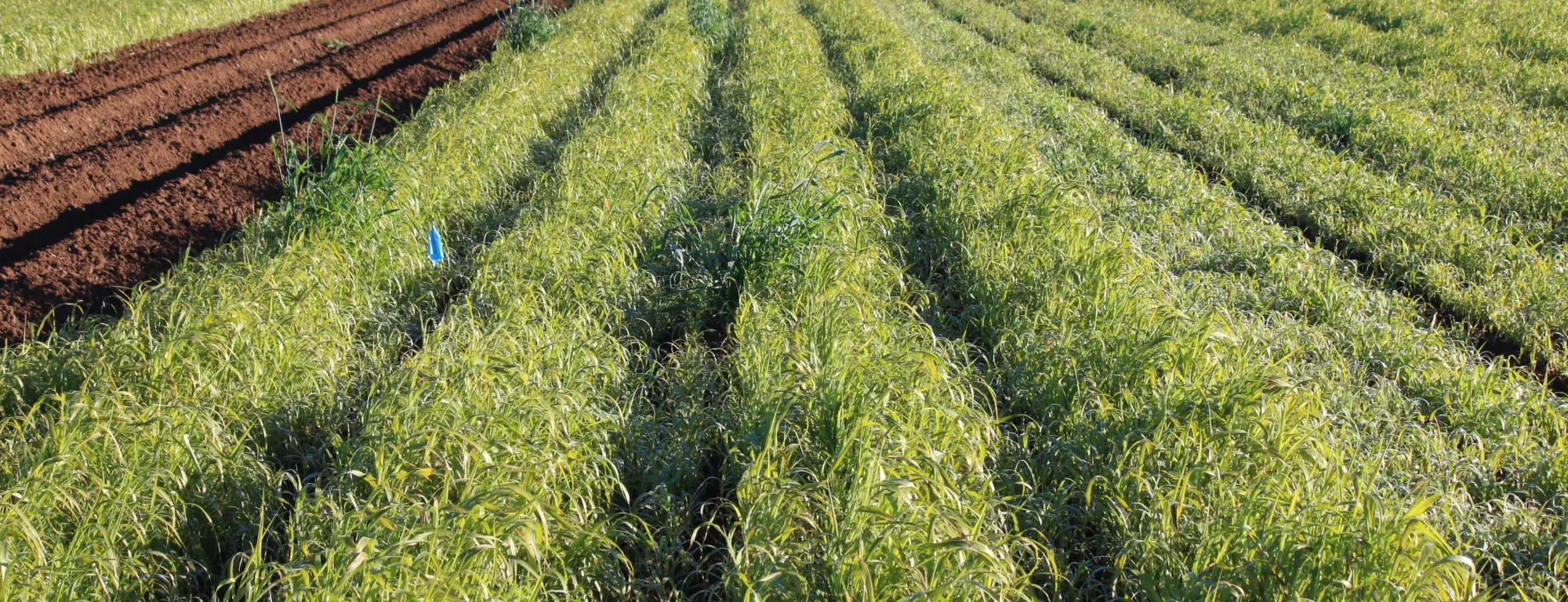
As we enter the fall season and begin preparing fields for the winter, this is the time to think about planting cover crops. Typically, most growers plant less than 5% of the vegetable ground with fall and winter cover crops. Cover crops can potentially help with many challenges that the Salinas Valley faces, including lessening nitrate leaching, improving soil health, and increasing soil organic matter content. During intense rain events winter cover crops reduce soil erosion, increase aquifer recharge, minimize flooding, as well as protect surface water quality.
The diversity of vegetables and intensity of crop rotations that occur in the Salinas valley means that fitting in a cover crop in the fall and winter is challenging. Some fields are not harvested until November, and other fields are planted as early as late December, so the window for growing a cover crop can be less than a few months. Most fields are listed into beds for winter and early spring planting, so cover crops can only be planted on flat ground in fields that do not need to be bedded up for 2 or more months.
Nonetheless, several strategies can be pursued to fit in a cover crop under many of these restraints. Cover crops can be planted in the late summer (late august or September) and incorporated into the soil before listing in late fall (November). Cover crops can also be planted on listed beds and then killed or incorporated a few weeks before planting a vegetable crop in late winter or early spring. However, the “devil is in the details” as they say. Success will depend on the species selection, weed pressure, seeding rate, planting equipment, soil type, and weather. Irrigation, weed control, and crop termination options need to be considered. In other words, start small and get experience with any new approach to using cover crops before implementing it across many acres. The following describes several strategies that could be tried to get more acres planted with fall and winter cover crops.
Planting cover crops on flat ground
A cover crop can often be planted on flat ground when the window between harvest of the last vegetable crop of the season and bed preparation s is greater than 2 months. A late summer/early fall cover crop can take up mineral nitrogen that has accumulated in the soil over the growing season, thereby preventing nitrate leaching losses during winter rain events. A grain crop such as wheat, barley, or Merced rye (Fig. 1), or a mixture of these species planted in late august to early October has been shown to take up more than150 lbs of N per acre in less than 60 days and accumulate more than 2 tons of dry matter per acre. However, it is important to terminate these grain species before they set viable seed. This can be done by disking in the cover crop or flail mowing it and leaving the residue on the surface so that it can breakdown before listing up the beds.
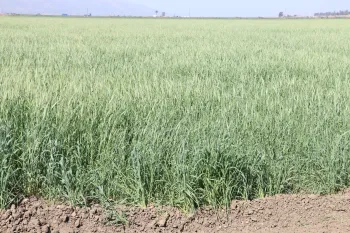
Planting cover crops on beds.
Since most vegetable fields are listed into beds during the fall for winter and spring plantings, it makes sense to plant cover crops on beds and/or in furrows. This practice can greatly reduce soil erosion during intense winter storm events, increase aquifer recharge, lessen salinity, and protect surface water quality. Cover crops can also take up significant amounts of residual mineral nitrogen in the soil, thereby reducing nitrate leaching losses. The challenge is to terminate cover crops planted on beds with sufficient time for the residue to break down before planting a vegetable crop. Also weed control can be challenging during the winter depending on when the cover crop is planted and terminated.
One approach to bed grown cover crops is to limit the biomass to less than 0.5 to 1 ton of dry matter per acre. This can be done by killing the cover crop with an herbicide such as roundup (glyphosate) in the early winter. This was shown to work well with late fall planted Merced rye, barley, and triticale planted in the furrows or furrows and beds (Fig. 2). The main concern is accessing fields during the winter with a tractor to spray the cover crop with herbicide. This may be logistically possible to do on a limited number of fields, but on many fields, it can be challenging to accomplish, especially when a series of winter rainstorms occurs. The recent use of drones for spraying may open a new opportunity for using this low biomass cover crop strategy. Drones can be launched from the edge of wet fields and quickly apply an herbicide to kill a cover crop.
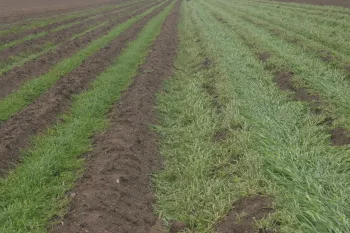
Another approach to low biomass cover crops is to plant warm season species such as sudangrass or sorghum-sudangrass hybrid. These species grow well under warm temperatures, but growth slows when the air temperature is below 50 °F, and almost stops as temperatures drop below 40 °F. Frosts will kill the foliage but usually not the growing point of these grass species (Fig.3). The main challenge with warm season adapted species is to plant early enough so that they accumulate sufficient biomass before the weather becomes cold in the Salinas Valley. Usually, late September through early October are the latest dates to plant sudangrass and sorghum-sudangrass. Also, one post-emergent herbicide application is usually necessary a few weeks after emergence before the crop becomes too tall. Because growth is slow in the winter, an herbicide application is not usually needed to limit the amount of biomass. Depending on the amount of biomass that is accumulated over the winter, these cover crops can be terminated by flail mowing followed by incorporation with a Lilliston cultivator (Fig. 4).
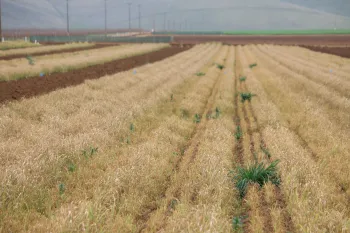
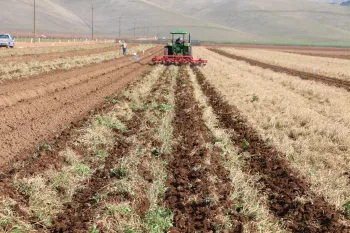
Another option for bed planted cover crops is to plant a white mustard species, such as Ida Gold. This species can be planted early through late fall. A potential advantage of mustard cover crops is that it they maybe better at suppressing weeds than sudangrass. Although growth will not slow as much in the winter as occurs with sudangrass, the biomass can be limited to less than 1 to 2 tons of dry matter residue by flail mowing, or an herbicide spray. As mustard biomass generally has a high nitrogen content, the residue tends to breakdown rapidly when incorporated into the soil.
Leaving cover crop residue as a surface mulch in the winter
After terminating a cover crop, delaying incorporation into the soil can provide several benefits. Leaving the residue on the surface for will inhibit weed growth, protect the soil from erosion and increase infiltration during rain events. Left on the surface, the rate of nitrogen mineralization can be reduced, which lessens the risk of nitrate loss through leaching. Also, for bed planted cover crops, allowing time for residue to break down on the surface will reduce the amount of tillage required to incorporate it into the beds before planting.
Conclusions
There are multiple approaches to help increase the acres of vegetable ground planted with fall and winter cover crops in the Salinas Valley. These strategies range from flat and bed planted cover crops and early fall and late fall plantings. Consideration is needed for managing weeds and terminating the cover crop, as well as selecting the appropriate species. Some species are best adapted for warm temperatures, like sudangrass, while other species, such as wheat and rye, can grow well under cold conditions. Some cover crops, such as mustards, are easy to terminate by mowing, while grain species may need to be disking or killed with an herbicide. Finally, leaving residue on the soil surface to breakdown can slow nitrogen mineralization during the winter and protect the soil from erosion during intense rain events, as well as reduce the number of tillage passes needed for incorporation.
Further reading on cover crop trials conducted in the Salinas Valley:
M. Cahn. 2024. Evaluation of sudangrass and sorghum-sudangrass hybrid cover crops for control of winter storm water runoff and erosion in vegetable systems Salinas Valley Agriculture Blog
R. Smith et al. 2022. Fall-Grown Cover Crop Evaluations. Salinas Valley Agriculture Blog
R. Smith et al. 2022. The risk of seed set by cover crops. Salinas Valley Agriculture Blog
Smith et al. 2012 Low biomass cover crops Youtube video
Smith et. al. 2006. Mustard Cover Crops to Optimize Crop Rotations for Lettuce Production. CLGRB report

